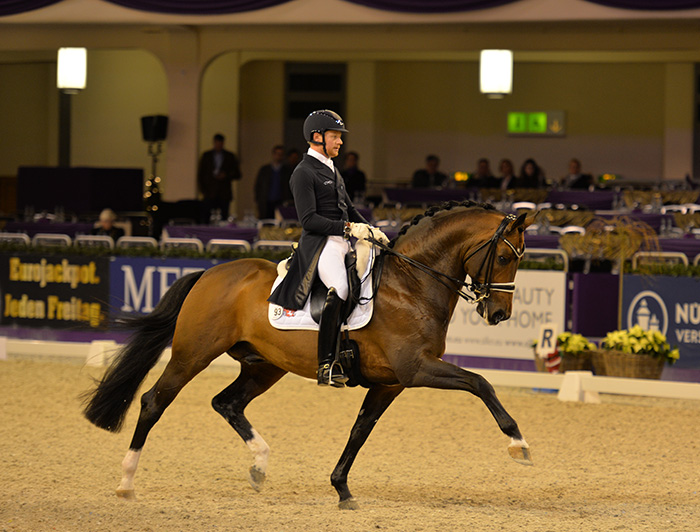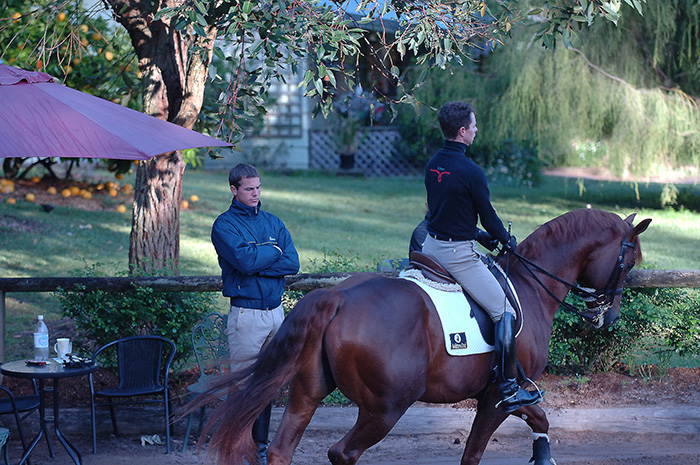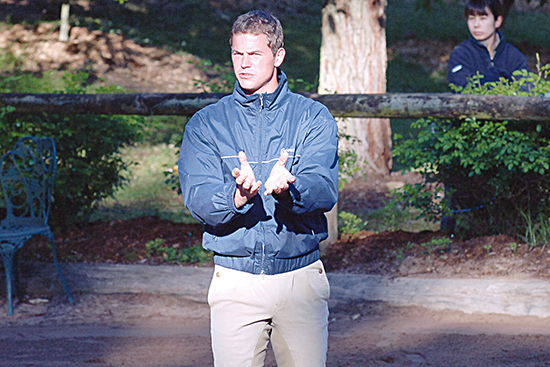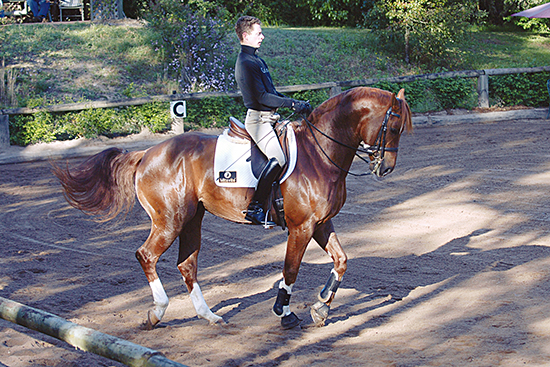Story by Chris Hector and photos by Roz Neave
Stefan Wolff has been visiting Australia for many years, our riders and trainers are fortunate to be able to share his skills both as a trainer and as a teacher.
Stefan Wolff is the complete professional, and even at the end of a 12 hour teaching stint, he was still focussed, still ready to produce a startlingly good lesson. But, he suggested, that had something to do with the quality of his pupils – Nick Fyffe and Ferrero Rocher.
“It can get a bit hard teaching such a long day, but it was good at the end, I had a very good rider – who knew what I wanted and easily put it into their work.”
Nick of course, tuned into the German training system during time in Germany spent with Martina Hannöver and Holga Finken. Then again it didn’t hurt that he was riding a German horse, the eight year old, the Florestan / Weltmeyer stallion, Ferrero Rocher.
Do you have a special problem? Stefan asked Nick.
“I want to get him more even on both sides. He is not so easy to get loose on the right side, and I feel it in the half pass and in the pirouette…”
And guess what Stefan’s opening advice to Nick was as he circled in walk?
“Give. Give so that he offers, so every touch of your leg goes through the whole body of the horse and doesn’t get stuck. Make him carry himself, then after the half halt, you can give again. He has huge movement, but you have to keep the natural dynamic of the movement. Give and follow the bit so that he stays in front of your leg… Give more than you think you can, give more than you are used to.”
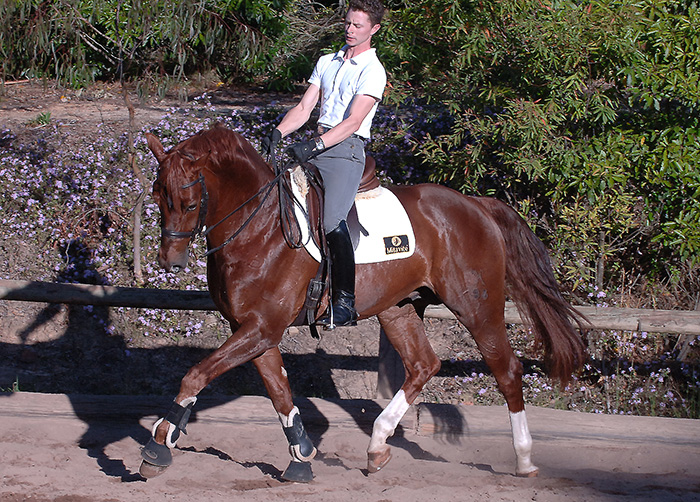
“It is easier for horses to relax their muscles when there is no hand in their mouth…”
“Before you drive him with your legs, always give the rein. The same amount you give is the same amount as you close behind, so the relation between hands and leg stays the same – you don’t give the rein and he falls apart. Give and follow and now he has space, and you can work him and get him in front of your leg.”
And of course, when they went to trot Ferrero Rocher wanted to show off his extravagant way of going. No.
“In trot, not too much expression. In working trot, give and make the trot quicker – quicker, not more expressive. Work so that you give and follow, rather than holding and closing from behind.”
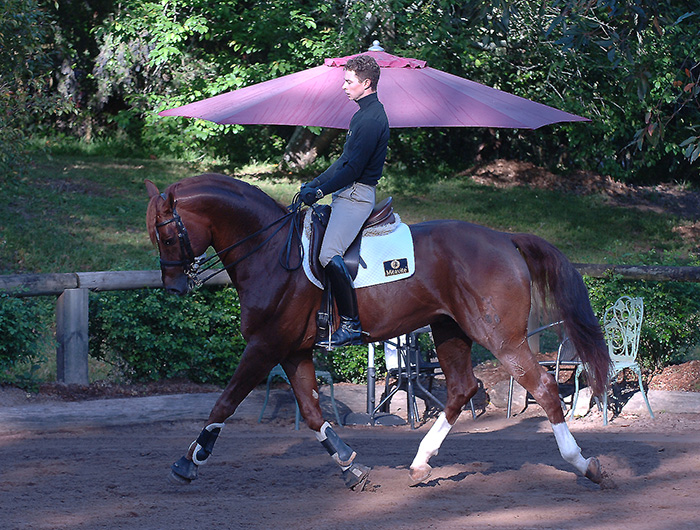
“Not quicker so he rushes, just a bit more electric. Make sure he knows that when you give, he follows – and give him time and space to react. Lighter – don’t touch the bit, you don’t need it. You have him so nicely on your seat, the next step is to have him lighter in the hand. Always try to make it easier, always the tendency to give and to follow. Don’t try to prevent him from running away by holding – if he runs away, give him a proper half halt, then give and ask him to be quicker behind.”
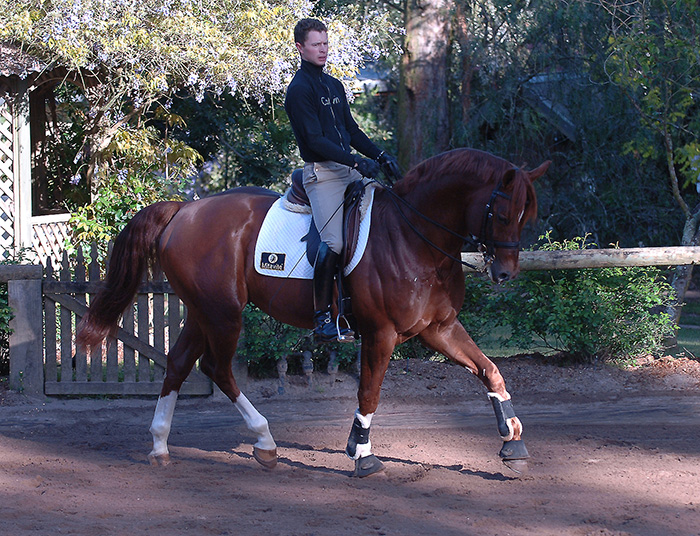
“You can push a horse forward with your leg aid, but you can also make the horse quicker. You have to touch the horse’s body before he touches the ground with his feet because then he can still bend more, then he will be quicker.”
“The easiest way for the horse to relax his muscles is to give the rein. Send a little wave of relaxation through the horse, start at the poll, through the body to the croup.”

For
More information on how Protexin can help your horse – www.iahp.com.au/australia/protexin or call 1800 801 201 (AUS) or 0800 424999 (NZ)
“Whisper to him, don’t show everybody – light contact, but keep it, with a breathing leg. Touch his mouth but don’t bring him back – touch just to relax the whole top line.”
“Do you ride passage with him?” Stefan asks.
“I stopped doing passage because the trot was becoming a bit passagey…”
“Don’t do so big passage – then trot out of it – so you get him going in the frame of passage but not too big. Not too expressive, flat easy passage, and don’t get stuck in passage – out in trot. And pat him and make him confident – there you are, tell him it is not torture for him. Especially in the higher collected movements, like canter pirouette or piaffe, give the rein and pat him and make him confident.”
And sure enough two very nice things happened – the passage was truer, and the trot was not at all passagey.
“If you work the passage like this, you get a better trot. If you work the passage too big, he comes back against your leg, and then the trot gets worse. If the impulsion is not interrupted by too much bounce, then it is really straight forward.”
“Now let him out, three or four times every lesson, let him go long and deep until he is really relaxed.”
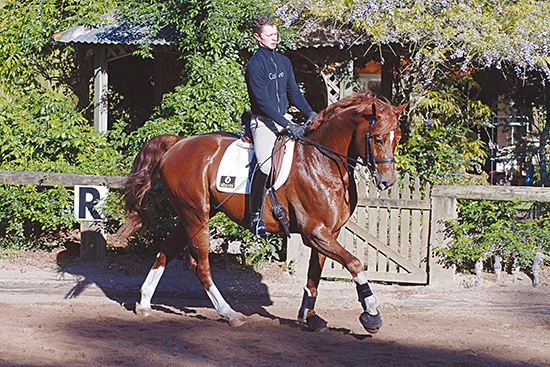 Time to work on the half passes, but first a little preparation in shoulder in. Once again, the emphasis is on keeping the natural forward dynamic of the movement: “In the shoulder in, keep him flowing forward, not slower. Give and forward, if he tries to come back, notice it earlier and fix it when he tends to come behind the leg.”
Time to work on the half passes, but first a little preparation in shoulder in. Once again, the emphasis is on keeping the natural forward dynamic of the movement: “In the shoulder in, keep him flowing forward, not slower. Give and forward, if he tries to come back, notice it earlier and fix it when he tends to come behind the leg.”
And of course, we want that half pass flow: “Make him a little lower in the neck so he has relaxed back muscles. Make sure you don’t get stuck, stay loose in your seat. In the preparation get him lower in the neck, then you can work him up a little in the half pass. Give and go, more giving after the half halt. Don’t be too conservative, really there should be nothing else but the weight of the rein in his mouth – if he then starts to get strong, half halt.”
And Nick gives, and stays in that giving feeling, and the horse really looks so different…
“I think I try to hold him together too much.”
“It is important that he moves himself, that you don’t have to keep pushing. And always the lightest contact, only the weight of the reins in the mouth. Now bend him a little but don’t take any weight, even if you take rein, he should stay light. Now take him up to passage but keep the rhythm, keep him lower in the neck so he can relax the back muscles, then just bring him back. Even if he gets a little forwards / backwards, you sit in the middle and let him look to you for balance. Now let him trot out and give and follow…”
“As soon as you touch his mouth, think of sending relaxation through the body.”
“Back to passage but relax your body. Only concentrate on the rhythm of passage, keep thinking of all the work you do in trot to make him supple and gymnastic also in the passage work.”
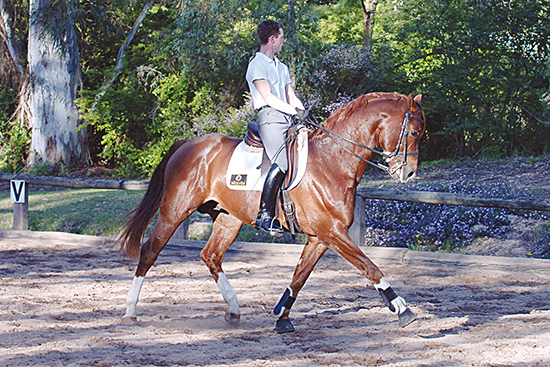 “If you feel you get stuck, do some easy, walk / trot transitions.”
“If you feel you get stuck, do some easy, walk / trot transitions.”
It was time for some canter work, and we were giving and following yet again:
“Give and follow, but get him soft before you bring him back. Soft, then follow. Collect the canter a little but be careful he doesn’t block because when you take away the fluid movement you have problems when you want to go forward again. Only bring him back as much as you can without him getting stuck.”
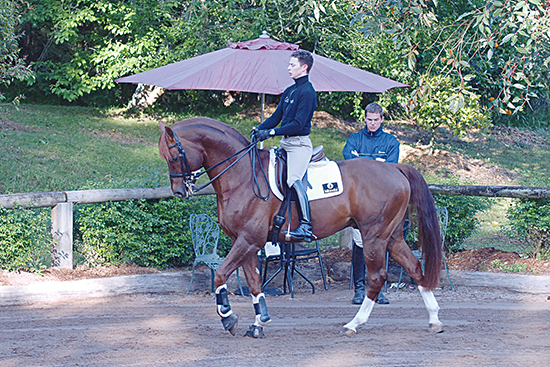
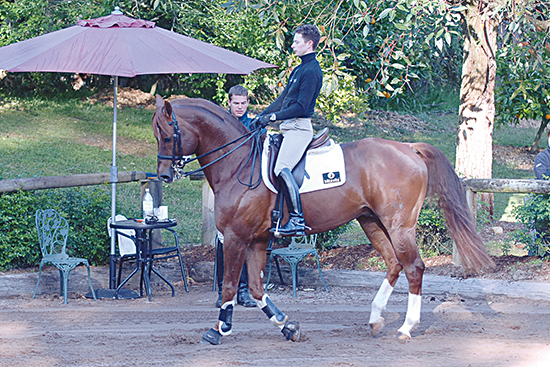
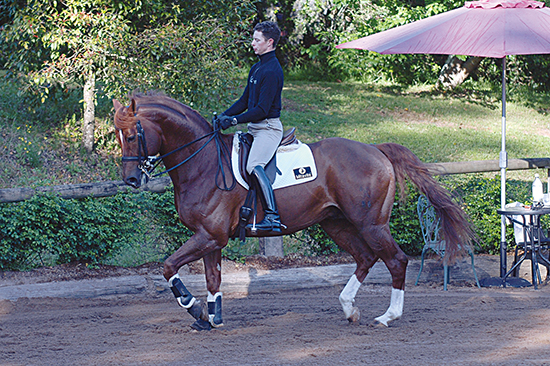
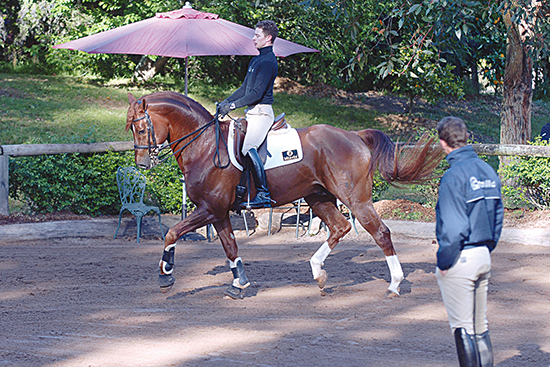 “Bring him back, but soften him in the poll – THERE – and out. Sit a little more back in the saddle, bring him back and stay loose in your legs. Make sure that he constantly follows his neck, and goes forward as much as you allow: loosen, supple, more supple,…”
“Bring him back, but soften him in the poll – THERE – and out. Sit a little more back in the saddle, bring him back and stay loose in your legs. Make sure that he constantly follows his neck, and goes forward as much as you allow: loosen, supple, more supple,…”
Stefan’s session working with Nick on piaffe was truly amazing – can you believe, relaxed piaffe?
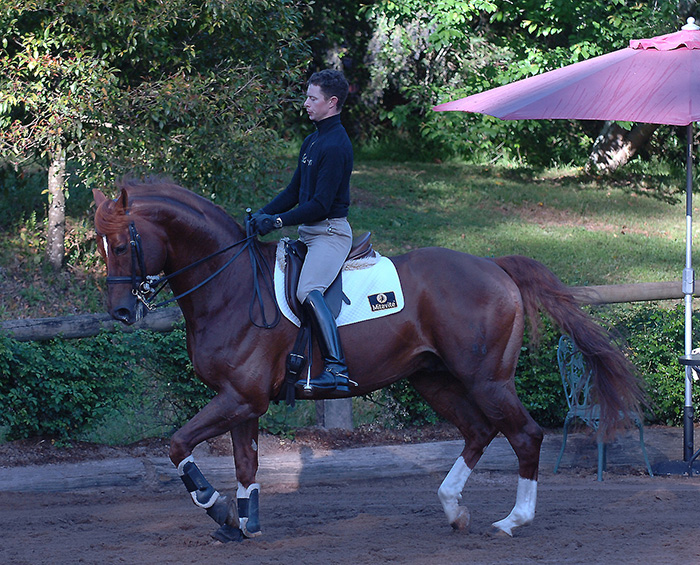
“We want the piaffe to come out of walk. Walk on the spot and just develop it. No tension. Don’t chase him away with your leg, give the rein, give the rein. Yes!”
“Now he is nicely staying at your seat. Take him a little higher, but put no weight in his mouth. Halt / walk / halt / walk. Cool him down in his mind, make the contact a little softer. At the Cadre Noir they work the horses like this in hand for days – halt / walk / halt / walk. When it is perfect, they start to work on piaffe. Get rid of the tension here, otherwise you will have so much trouble when you start to work on piaffe because you still have tension.”
“Be careful, now he doesn’t do the work by himself, it is a little bit ‘I do it because you want it…’ He must do it himself. Just make it easy so he doesn’t get stressed or have a bad experience.”
Thank you Stefan for another wonderful lesson. Come back to Australia soon.
Nick Fyffe – Working with Stefan
“I had lessons with Stefan the first time he came out – and I realised in the first lesson of this clinic, that I’d let slide what I’d learnt last time. It’s never anything new that you hear. It’s unfortunate that it takes a really expensive lesson and European accent before it filters in.”
“It took me a good few minutes into the lesson to get the feeling we were both after, but when I got it, I could appreciate and understand the direction we were taking.”
A lot of it was about engagement and forward? And letting it really flow through?
“For sure, it’s a very good horse and a lot of people think that makes it easier but it also means that I have to let the horse work more on his own. I want to work him too much, when I need to let him do the work more because he can do it.”
Stefan was suggesting that with a horse with as much movement as that, it is very easy for the horse to lose what he called the ‘natural dynamics’…
“Yeah, the natural dynamics. Because he is such an exciting horse to ride you want to push him a little and you can lose the basic quality of the pace trying to get too fancy. I don’t need to make the movement any bigger than it is – it’s hard not to try though on a horse like that.”
It was interesting his concept of getting the passage flatter and more trot-like…
“It’s almost the opposite of what you would think that you would want to do – but when I went for that feeling I could control and ride the passage, and then I thought I could manipulate it more. That’s not what I thought I should be after, and it’s not what I’ve been doing, but when I tried it, it definitely made the passage more rideable.”
With every horse I’ve seen him teach, the frame has come longer and freer?
“And easier, they are carrying their necks on their own now. I’m not sweating as much as I would normally be, and the horse isn’t sweating so much either even though he worked really hard – that has to be good. We are all desperate to be good and I think we try to do it too physically and we just have to be a bit more mental in our approach to riding, feel the problems and make the adjustments without trying to muscle it all the time.”
Interested in breeding dressage horses? Interested in the famous ‘F’ line? The current star performer and producer, Foundation, is available in Australia through International Horse Breeders: www.ihb.com.au
